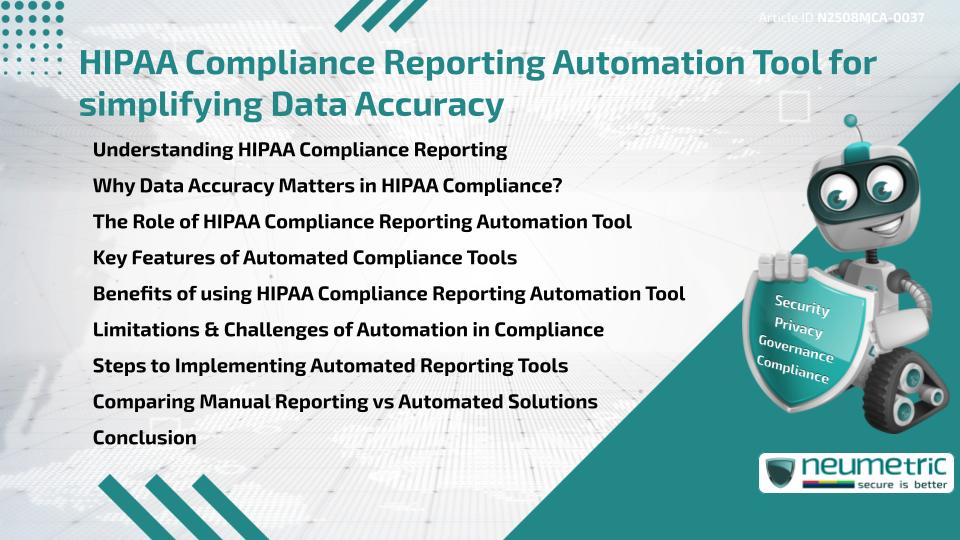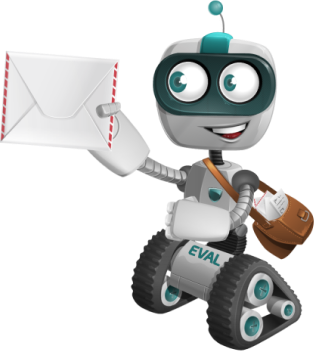Table of Contents
ToggleIntroduction
The Health Insurance Portability & Accountability Act [HIPAA] requires Healthcare Organisations & their partners to safeguard sensitive patient health information [PHI]. One critical aspect of compliance involves accurate reporting of Privacy, security & breach-related activities. However, manual reporting is time-consuming & prone to errors. This is where a HIPAA Compliance Reporting Automation Tool becomes invaluable. By automating data collection, validation & reporting processes, these tools simplify compliance, minimize errors & improve data accuracy, making audits smoother & faster.
Understanding HIPAA Compliance Reporting
HIPAA Compliance Reporting refers to the documentation & submission of Policies, Risk Assessments, incident reports & workforce training records. Regulatory agencies, including the Office for Civil Rights [OCR], use these reports to evaluate how well Organisations comply with Privacy & security rules. Compliance Reporting is not only a legal requirement but also a way to demonstrate accountability & build trust with patients. Traditional manual reporting, however, often requires significant human effort & constant oversight.
Why Data Accuracy Matters in HIPAA Compliance?
Accurate reporting is vital in maintaining compliance. Inaccuracies can misrepresent an organisation’s security posture, potentially leading to fines, reputational damage or even legal action. For example, incorrect records of Employee Training or missed incidents could suggest negligence. Data accuracy ensures transparency, helps identify real compliance gaps & provides Auditors with confidence that the organisation meets HIPAA requirements. Without reliable reporting, even strong compliance programs can appear insufficient.
The Role of HIPAA Compliance Reporting Automation Tool
A HIPAA Compliance Reporting Automation Tool centralizes compliance data & streamlines the reporting process. It integrates with existing IT systems, automatically pulls relevant data & generates reports that meet regulatory requirements. Instead of manually compiling spreadsheets & documents, compliance officers can rely on these tools for real-time updates. Automation reduces the Risk of errors, shortens Audit preparation time & ensures that reporting stays consistent across the Organisation.
Key Features of Automated Compliance Tools
Most automated compliance tools provide a range of features tailored to HIPAA requirements:
- Automated Data Collection: Pulls information from security systems, training logs & incident management tools.
- Validation & Error Checking: Flags incomplete or inconsistent data for correction.
- Customizable Reporting Templates: Generates reports that meet auditor expectations.
- Real-Time Dashboards: Provides visibility into compliance status & potential Risks.
- Audit Trails: Tracks changes & updates for accountability.
These features work together to simplify reporting, making compliance officers more efficient & audits more reliable.
Benefits of using HIPAA Compliance Reporting Automation Tool
The advantages of automation in Compliance Reporting are substantial:
- Improved Accuracy: Automated data validation reduces human error.
- Time Savings: Reporting tasks that once took weeks can be completed in hours.
- Better Audit Readiness: Organisations are always prepared for audits with up-to-date reports.
- Cost Efficiency: Reduces the need for excessive manual labor.
- Transparency: Provides Auditors with clear, consistent evidence of compliance.
These benefits highlight why many Healthcare Organisations adopt automated tools to simplify compliance.
Limitations & Challenges of Automation in Compliance
While automation offers clear benefits, it is not without challenges. Smaller Organisations may find the cost of advanced tools prohibitive. Integrating automation with legacy IT systems can also be complex. Additionally, relying too heavily on automation without human oversight can create blind spots. Compliance officers must still review reports, interpret results & ensure that the data reflects real-world practices.
Steps to Implementing Automated Reporting Tools
Organisations planning to adopt a HIPAA Compliance Reporting Automation Tool should follow a structured approach:
- Identify Requirements: Assess reporting needs & compliance gaps.
- Evaluate Vendors: Look for tools with proven track records & strong security Certifications.
- Pilot the Tool: Test with a limited dataset before full implementation.
- Train Staff: Ensure compliance officers & IT teams understand how to use the system.
- Monitor & Adjust: Continuously refine processes to maximize efficiency.
By following these steps, Organisations can ensure smooth implementation & long-term success.
Comparing Manual Reporting vs Automated Solutions
Manual reporting requires staff to collect, review & compile compliance data, often across multiple departments. This approach is prone to duplication, delays & errors. Automated solutions, on the other hand, streamline the process by consolidating data & generating reports in real time. It is similar to the difference between hand-calculating complex equations & using a calculator-both achieve results, but one is significantly faster, more reliable & less error-prone.
Conclusion
A HIPAA Compliance Reporting Automation Tool simplifies the burden of compliance management by ensuring accuracy, consistency & efficiency. While automation should not replace human oversight, it provides Healthcare Organisations with a reliable way to meet HIPAA requirements & maintain Audit readiness. With the right balance of technology & expertise, Organisations can strengthen compliance & reduce Risk.
Takeaways
- HIPAA Compliance Reporting ensures accountability & protects sensitive Patient Data.
- Data accuracy is critical for avoiding fines & maintaining trust.
- Automation tools reduce human error, save time & simplify reporting.
- Costs & integration challenges are key limitations of automation.
- Combining automated tools with human oversight delivers the best outcomes.
FAQ
What is a HIPAA Compliance Reporting Automation Tool?
It is a software platform that automates the collection, validation & generation of Compliance Reports required under HIPAA.
How does automation improve HIPAA reporting accuracy?
By automatically pulling data from trusted sources & checking for inconsistencies, automation minimizes errors caused by manual processes.
Can automated tools replace compliance officers?
No. Automation supports compliance officers but does not replace their role in interpreting data & ensuring organizational culture aligns with HIPAA.
Are automated reporting tools expensive?
Costs vary depending on features & vendor, but many solutions offer scalable pricing that adapts to organizational size.
What Risks exist with automation in Compliance Reporting?
Risks include over-reliance on automation, integration difficulties & costs. Human oversight remains essential to balance these Risks.
How quickly can Automation Tools generate reports?
Reports that might take weeks to prepare manually can often be generated within hours using automation.
Do automated tools support training documentation?
Yes. Many platforms include modules to track & document workforce training compliance.
Need help for Security, Privacy, Governance & VAPT?
Neumetric provides organisations the necessary help to achieve their Cybersecurity, Compliance, Governance, Privacy, Certifications & Pentesting needs.
Organisations & Businesses, specifically those which provide SaaS & AI Solutions in the Fintech, BFSI & other regulated sectors, usually need a Cybersecurity Partner for meeting & maintaining the ongoing Security & Privacy needs & requirements of their Enterprise Clients & Privacy conscious Customers.
SOC 2, ISO 27001, ISO 42001, NIST, HIPAA, HECVAT, EU GDPR are some of the Frameworks that are served by Fusion – a SaaS, multimodular, multitenant, centralised, automated, Cybersecurity & Compliance Management system.
Neumetric also provides Expert Services for technical security which covers VAPT for Web Applications, APIs, iOS & Android Mobile Apps, Security Testing for AWS & other Cloud Environments & Cloud Infrastructure & other similar scopes. Reach out to us by Email or filling out the Contact Form…


